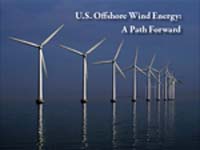Report Charts Path for U.S. Offshore Wind Power Development
 A new report calls for coordinated activities among government agencies, universities, and businesses to nurture and develop offshore wind power in the United States. The U.S. Offshore Wind Collaborative (USOWC) released its study “U.S. Offshore Wind Energy: A Path Forward” in late October as a call to action for this renewable resource.
A new report calls for coordinated activities among government agencies, universities, and businesses to nurture and develop offshore wind power in the United States. The U.S. Offshore Wind Collaborative (USOWC) released its study “U.S. Offshore Wind Energy: A Path Forward” in late October as a call to action for this renewable resource. Citing a DOE finding that the United States possesses the potential for 900,000 megawatts (MW) of electricity from its offshore wind resources, the report lays out specific areas needed to make offshore wind a U.S. reality.
Among the recommendations: better collaboration among government entities, universities, businesses, and stakeholders in wind development; creation of a Web-based information clearinghouse; convening meetings among states with common interests in offshore wind, as well as between the United States and its European counterparts; and providing leadership to build public trust and investor confidence in offshore wind potential. The report and OSOWC Web site also provide an overview of offshore wind power activities throughout the United States.

Current efforts to develop offshore wind power in the United States include the 468-MW Cape Wind project, proposed for Horseshoe Shoal in Nantucket Sound, about 4.7 miles off the shore of Cape Cod. While that project awaits a federal permit, others are also being considered along the East Coast. In Delaware, Bluewater Wind has signed an agreement to deliver 200 MW of offshore wind power to Delmarva Power, starting around the year 2012.
In Maryland, the Maryland Energy Administration (MEA) recently began a new initiative to explore the potential for developing the state’s offshore wind resources. And in North Carolina, the Duke Energy Corp. and the University of North Carolina, Chapel Hill, recently announced plans to build up to three demonstration turbines in eastern Pamlico Sound, about 7 to 10 miles from the Outer Banks.
Efforts are also underway to develop offshore wind power in the Great Lakes. Last year, the Land Policy Institute (LPI) at Michigan State University issued a offshore wind power report, finding the potential for nearly 322 gigawatts of power production off the state’s coast. This September, the Michigan Great Lakes Wind Council (GLWC) delivered a report to Governor Jennifer Granholm highlighting 587 square miles of state-owned Great Lakes bottomlands considered “most favorable” for wind energy development, and highlighting legislative and rule changes needed to encourage the development of the offshore resource.
Meanwhile, the Ohio-based Great Lakes Energy Development Task Force has issued a feasibility study for an offshore wind power facility in Lake Erie, near Cleveland. The report found that a pilot project of up to 20 MW, located 3-5 miles from shore, would be feasible and would cost up to $92 million. Case Western Reserve University (CWRU) helped to fund the report.
For More Information: US Department of EnergyYou can return to the main Market News page, or press the Back button on your browser.

